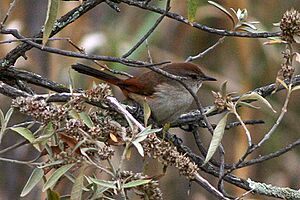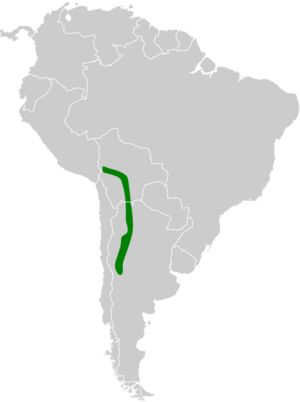Rusty-vented canastero facts for kids
Quick facts for kids Rusty-vented canastero |
|
|---|---|
 |
|
| Conservation status | |
| Scientific classification | |
| Genus: |
Asthenes
|
| Species: |
dorbignyi
|
| Subspecies | |
|
See text |
|
 |
|
| Synonyms | |
|
Bathmidura dorbignyi (Reichenbach) |
|
The rusty-vented canastero (Asthenes dorbignyi) is a type of bird found in Argentina and Bolivia. It belongs to the ovenbird family called Furnariidae. This bird is also sometimes called the creamy-breasted canastero.
Contents
About Its Name and Family
Scientists often group living things into families. This helps us understand how different animals are related. For the rusty-vented canastero, there are two main groups, or subspecies, that scientists agree on. These are A. d. dorbignyi and A. d. consobrina.
Sometimes, scientists have different ideas about how to classify birds. They look at things like how birds look, sound, and build their nests. This helps them decide if a bird is a separate species or a subspecies. For the rusty-vented canastero, some scientists think there might be more subspecies or even that some of these birds could belong to a different bird family entirely!
What It Looks Like
The rusty-vented canastero is a medium-sized bird. It is about 14.5 to 16.5 centimeters (5.7 to 6.5 inches) long. It weighs between 17.5 and 24 grams (0.6 to 0.8 ounces). Both male and female birds look very similar.
Adult birds have a light gray stripe above their eye. Their face is a dull buff color. The top of their head, neck, and back are pale brown. Their lower back and the feathers under their tail are a reddish-brown color.
Their wing feathers are dark, but the inner ones have wide reddish-brown edges. The outer tail feathers are reddish, while the rest are blackish. The center of their throat is a bright orange-red. Their chest and belly are a creamy white. The sides of their body are a reddish-brown, and the feathers under their tail are also reddish.
Young birds, called juveniles, have a completely white throat. They might have faint dark spots or lines on their chest and belly.
Where It Lives and Its Home
The rusty-vented canastero lives in the Andes mountains. One group, A. d. dorbignyi, is found in central Bolivia and goes south into northwestern Argentina. The other group, A. d. consobrina, lives in southwestern Bolivia.
These birds like dry places. They often live in scrublands, which are areas with small bushes and shrubs. They also live in nearby woodlands.
Behavior
Movement
The rusty-vented canastero stays in the same area all year long. It does not migrate to different places.
Feeding Habits
These birds mainly eat small insects and other arthropods, like spiders. They also eat some seeds. They look for food on the ground or in low bushes and trees. They usually search for food alone or in pairs.
Reproduction and Nests
The rusty-vented canastero builds a very interesting nest. It is shaped like a ball and made of sticks, some of which are thorny. The nest has an entrance near the top. This leads to a tunnel that goes to the main nest chamber. The inside of the chamber is soft, lined with wool, feathers, and soft plant material.
They build their nests in shrubs, small trees, or even on tall cactus plants. Sometimes, several nests can be found in one tree. Both the male and female birds help build the nest.
Scientists believe these birds stay with one partner for life. Small family groups often sleep in their nests all year round. Not much else is known about how they raise their young.
Vocalization
The song of the rusty-vented canastero can start with a few notes. Then, it gets faster and higher in pitch. Towards the end, it slows down and gets lower. Its call sounds like a "wheezy" or "rising, penetrating shreep!" sound. These birds usually sing from the top of a bush or a small tree.
Status
The rusty-vented canastero is considered a species of "Least Concern" by the IUCN. This means it is not currently in danger of disappearing. It lives across a large area. However, the total number of these birds is not known, and it is thought to be decreasing.
There are no major threats identified right now. The main reason its numbers might be going down is because people are clearing its habitat. This reduces the amount of space and good quality homes for the birds.


